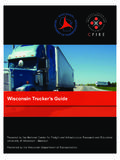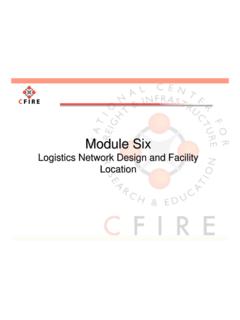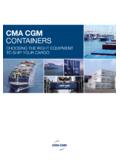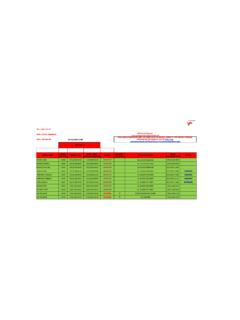Transcription of INTRODUCTION TO THE CONTAINER SHIPPING …
1 INTRODUCTION TO THE CONTAINER SHIPPING INDUSTRY University of Wisconsin Milwaukee Paper No. 11-1 National Center for Freight & Infrastructure Research & Education College of Engineering Department of Civil and Environmental Engineering University of Wisconsin, Madison Author: Matthew E. H. Petering Department of Industrial and Manufacturing Engineering University of Wisconsin Milwaukee Principal Investigator: Alan J. Horowitz Professor, Civil Engineering and Mechanics Department, University of Wisconsin Milwaukee January 6, 2011 INTRODUCTION to the CONTAINER SHIPPING Industry INTRODUCTION This document contains images of all slides in a course module about the CONTAINER SHIPPING industry and CONTAINER port operations. Sources and additional content are found on the note pages of the original slide presentation. The full presentation contains videos. This presentation is available upon request to Alan Horowitz, 1 INTRODUCTION to the INTRODUCTION to the CONTAINER SHIPPING IndustryContainer SHIPPING IndustryMatthew E.
2 H. PeteringAssistant ProfessorDepartment of Industrial and Manufacturing EngineeringUniversity of Wisconsin 2010 Matthew E. H. to maritime to CONTAINER vessels and SHIPPING CONTAINER transportation / to maritime to CONTAINER vessels and SHIPPING CONTAINER transportation / to Maritime ShippingIntroduction to Maritime ShippingzShips carry 99% of overseas trade in volume terms and 62% in value terms, the remainder being conveyed by of all international trade moves by seazGlobally, the ton-miles of freight moved by water are more than twice the total ton-miles moved by road, railway, and air put transportation is less costly and more energy efficient than other modes of transport:5 Maritime SHIPPING : Cargo TypesMaritime SHIPPING : Cargo Types Dry Bulk(salt, grain, minerals, cement/gypsum, coal byproducts) Liquid Bulk(crude oil, gasoline, chemicals, liquefied natural gas) Break Bulk(steel, lumber, heavy machinery) Automobile Containerized(finished consumer goods)6 Shippers (importers/exporters)(Nike, Wal-Mart, ExxonMobil, Toyota) SHIPPING lines (ocean carriers, vessel operators)(Maersk Sealand, MSC, CMA CGM, Evergreen, Hapag Lloyd) Seaport terminal operatorsMorton Salt (dry bulk)Shell Oil (liquid bulk)Toyota (automobile)Containerized cargo:PSA Corporation (Singapore)Hutchison Port Holdings (Hong Kong)Dubai Ports World (United Arab Emirates)APM Terminals (Netherlands, Denmark) Railway operators(Union Pacific, BNSF, CSX, Norfolk Southern, CN, CP) Trucking companies (motor vehicle carriers)Maritime SHIPPING : Major PlayersMaritime SHIPPING .
3 Major to maritime to CONTAINER vessels and SHIPPING CONTAINER transportation / ShippingContainer ShippingWorld fleet, Feb 2004: 3167 vessels, capacity = million 20-ft conts. (TEU)World fleet, Dec 2008: 4661 vessels, capacity = million 20-ft conts. (TEU)Port of Long BeachPort of Long Beach9 CONTAINER ShippingContainer ShippingPort of Long BeachFrankfurt am Main EastPort of Singapore 10 VesselsVessels11 ContainersContainersContentsfurniture, toys, footware, clothing, auto parts, electronics, computers, bananas, pineapples, foodstuffs, meat, fishSizes20' x 8' x ' high (TEU)40' x 8' x ' high (FEU)45' x 8' x ' highCapacity30 tonsWhere are they manufactured?ChinaTypesstandard dry, high cube ( ' high) (90%)refrigerated ("reefer")(5%)other: ventilated, open top, adjustable height (5%)QuantityGlobal stock = 35 million (10 mill leased); million produced in 2008 CostNew: $2000 - $20,000; lease rate $1 - $6 per day (5 year term)12 ContainersContainers Hoisted, lowered, and secured at the corners13 ContainersContainers Hoisted, lowered, and secured at the corners Secured aboard vessels, trains, truck chassies using (1) twist locksfor securing adjacent containers in the same stack(2) lashing rods (vessels only)for securing containers in high tiers directly to the deck14 ContainersContainers Hoisted, lowered, and secured at the corners Secured aboard vessels, trains, truck chassies using (1) twist locksfor securing adjacent containers in the same stack(2) lashing rods (vessels only)for securing containers in high tiers directly to the deck15 ContainersContainers Hoisted, lowered, and secured at the corners Secured aboard vessels, trains, truck chassies using (1) twist locksfor securing adjacent containers in the same stack(2) lashing rods (vessels only)
4 For securing containers in high tiers directly to the deck16 ContainersContainers Hoisted, lowered, and secured at the corners Secured aboard vessels, trains, truck chassies using (1) twist locksfor securing adjacent containers in the same stack(2) lashing rods (vessels only)for securing containers in high tiers directly to the deck17 Port of Long Beach Website Import cargo generally starts at an overseas manufacturer, supplier or consolidation facility. The US buyer may contact an industry professional known as a Freight forwarder or logistics company. Import cargo generally starts at an overseas manufacturer, supplier or consolidation facility. The US buyer may contact an industry professional known as a Freight forwarder or logistics Product Ordered: A typical import transaction starts when a wholesaler, retailer or other buyer orders products from an overseas manufactures 1- Product Ordered: A typical import transaction starts when a wholesaler, retailer or other buyer orders products from an overseas manufactures 2- To port: Once the product has been ordered and packaged, the buyer or freight forwarder will arrange for a local trucking company to move the CONTAINER to seaport, and then for a ship to transport the CONTAINER oversea.
5 2- To port: Once the product has been ordered and packaged, the buyer or freight forwarder will arrange for a local trucking company to move the CONTAINER to seaport, and then for a ship to transport the CONTAINER oversea. 3- Security checks: A Customs official based at the port receives information from a command center about which containers may be a security risk. 3- Security checks: A Customs official based at the port receives information from a command center about which containers may be a security risk. 4- All abroad: When the CONTAINER is cleared by security it will be placed on a ship along with as many as 8,000 TEU (twenty-foot equivalent) containers. 4- All abroad: When the CONTAINER is cleared by security it will be placed on a ship along with as many as 8,000 TEU (twenty-foot equivalent) containers. 5- Coast Guard review: The Coast Guard reviews crew and cargo manifestinformation, which must be delivered at least three days before any ship arrives at Coast Guard review: The Coast Guard reviews crew and cargo manifestinformation, which must be delivered at least three days before any ship arrives at Vessel docked: As the ship nears the harbor it will be boarded by a port pilot, maritime specialists with expert knowledge of the harbor Vessel docked: As the ship nears the harbor it will be boarded by a port pilot, maritime specialists with expert knowledge of the harbor Unloading the ship: As the ship is arriving, the terminal operator will contact the local union hall and arrange for unionized longshore workers to unload the CONTAINER (using a giant, electric gantry crane) and place it onto a truck, a rail car or temporary storage area on the terminal property.
6 Unloading an 8,000 TEU ship takes about three Unloading the ship: As the ship is arriving, the terminal operator will contact the local union hall and arrange for unionized longshore workers to unload the CONTAINER (using a giant, electric gantry crane) and place it onto a truck, a rail car or temporary storage area on the terminal property. Unloading an 8,000 TEU ship takes about three Security Checks: Customs officials conduct further analysis and determine which containers warrant further Security Checks: Customs officials conduct further analysis and determine which containers warrant further Radiation detection: As a final security safeguard, containers pass through large portals that detect Radiation detection: As a final security safeguard, containers pass through large portals that detect of Long Beach Website As with imported goods, exported cargo may require several intermediate stops between the producer or manufacturer of the cargo and the Port.
7 As with imported goods, exported cargo may require several intermediate stops between the producer or manufacturer of the cargo and the Direct Delivery: In the most straightforward route, asingle CONTAINER from a local exporting company, produce grower or manufacturer would be delivered bytruck directly to the marine Direct Delivery: In the most straightforward route, asingle CONTAINER from a local exporting company, produce grower or manufacturer would be delivered bytruck directly to the marine Warehouse/consolidator: Cargo delivered from local or nonlocal destinations may be stored temporarily at a warehouse or consolidated with other cargo bound for export. Cargo may also be transferred from domestic truck trailers to marine SHIPPING containers at this Warehouse/consolidator: Cargo delivered from local or nonlocal destinations may be stored temporarily at a warehouse or consolidated with other cargo bound for export.
8 Cargo may also be transferred from domestic truck trailers to marine SHIPPING containers at this Off-dock railyards: Some export cargo containers aredelivered by train to off-dock railyards, where they are placed onto trucks for final delivery to marine Off-dock railyards: Some export cargo containers aredelivered by train to off-dock railyards, where they are placed onto trucks for final delivery to marine On-dock railyards: Cargo bound for export can bedelivered by train directly to on-dock railyards, where it is loaded onto an ocean vessel. On-dock delivery requires no local truck On-dock railyards: Cargo bound for export can bedelivered by train directly to on-dock railyards, where it is loaded onto an ocean vessel. On-dock delivery requires no local truck Near-dock railyards: Export deliveries are also made to near-dock railyards, where the cargo is picked up by truck for a short trip to the marine Near-dock railyards: Export deliveries are also made to near-dock railyards, where the cargo is picked up by truck for a short trip to the marine Vessel loading: Outbound cargo is loaded ontoan ocean vessel headed for an overseas Vessel loading: Outbound cargo is loaded ontoan ocean vessel headed for an overseas of Long Beach Website From the port of Long Beach , containers are either transported by train or by truck to their final destination, or to one of several intermediate destinations such as a railyard, warehouse, distribution center, or transload facility ( a sorting, routing and short-term storage building).
9 A CONTAINER s final destination determine exactly what path it will take once it leaves the dock. From the port of Long Beach , containers are either transported by train or by truck to their final destination, or to one of several intermediate destinations such as a railyard, warehouse, distribution center, or transload facility ( a sorting, routing and short-term storage building). A CONTAINER s final destination determine exactly what path it will take once it leaves the Unloading the ship: When a ship arrives at the Port, the marine terminal operator will arrange for unionized longshore workers to unload the vessel. The terminal operator directs the longshore workers to place the cargo containers where they belong:on trains, trucks or on terminalproperty for temporary Unloading the ship: When a ship arrives at the Port, the marine terminal operator will arrange for unionized longshore workers to unload the vessel.
10 The terminal operator directs the longshore workers to place the cargo containers where they belong:on trains, trucks or on terminalproperty for temporary Freight forwarder: A CONTAINER s movements are determined by the cargo s owner, or an industry professional known as a freight forwarder or logistics provider . 2- Freight forwarder: A CONTAINER s movements are determined by the cargo s owner, or an industry professional known as a freight forwarder or logistics provider . 3- On-dock railyard: Cargo can be placed directly onto trains at the marine terminals on-dock railyards. 3- On-dock railyard: Cargo can be placed directly onto trains at the marine terminals on-dock railyards. 4- Near-dock railyards: Cargo is often transported by truck to larger near-dock railyards close to the Port. 4- Near-dock railyards: Cargo is often transported by truck to larger near-dock railyards close to the Port. 5- Off-dock railyards: Off-dock railyards are used to coordinate rail deliveries to non-local destinations.














